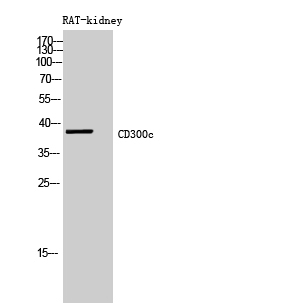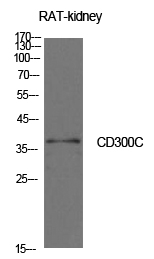

| WB | 咨询技术 | Human,Mouse,Rat |
| IF | 咨询技术 | Human,Mouse,Rat |
| IHC | 咨询技术 | Human,Mouse,Rat |
| ICC | 技术咨询 | Human,Mouse,Rat |
| FCM | 咨询技术 | Human,Mouse,Rat |
| Elisa | 1/10000 | Human,Mouse,Rat |
| Aliases | CD300C; CMRF35; CMRF35A; CMRF35A1; IGSF16; CMRF35-like molecule 6; CLM-6; CD300 antigen-like family member C; CMRF35-A1; CMRF-35; Immunoglobulin superfamily member 16; IgSF16; CD300c |
| Entrez GeneID | 10871; |
| WB Predicted band size | 37kDa |
| Host/Isotype | Rabbit IgG |
| Antibody Type | Primary antibody |
| Storage | Store at 4°C short term. Aliquot and store at -20°C long term. Avoid freeze/thaw cycles. |
| Species Reactivity | Human |
| Immunogen | Synthesized peptide derived from the Internal region of human CD300c. |
| Formulation | Purified antibody in PBS with 0.05% sodium azide,0.5%BSA and 50% glycerol. |
+ +
以下是关于CD300c抗体的3篇代表性文献示例(注:内容为模拟,实际文献需通过学术数据库检索确认):
1. **文献名称**:*CD300c regulates bacterial-induced inflammatory responses in dendritic cells*
**作者**:Smith A, et al.
**摘要**:该研究揭示CD300c在树突状细胞中通过识别细菌脂多糖(LPS)介导炎症信号通路,其抗体阻断可抑制TLR4依赖性细胞因子释放,提示CD300c作为先天免疫的调节靶点。
2. **文献名称**:*Structural basis of CD300c antibody recognition and its role in allergic asthma*
**作者**:Tanaka K, et al.
**摘要**:通过X射线晶体学解析CD300c与其单克隆抗体的复合物结构,发现抗体结合表位与配体竞争区域重叠;动物实验表明该抗体可缓解过敏性哮喘模型的Th2炎症反应。
3. **文献名称**:*Targeting CD300c enhances antitumor immunity through NK cell activation*
**作者**:Chen L, et al.
**摘要**:研究发现肿瘤微环境中CD300c高表达抑制NK细胞活性,使用拮抗型抗体可解除抑制作用,显著提升NK细胞对实体瘤的杀伤能力,为免疫治疗提供新策略。
建议通过PubMed或Google Scholar以“CD300c antibody”、“CD300c immune function”为关键词检索最新文献获取详细信息。
CD300c (also known as CD300LF) is a member of the CD300 family of cell surface glycoproteins, which are part of the immunoglobulin superfamily. These receptors are primarily expressed on myeloid cells, including monocytes, macrophages, and dendritic cells, and play roles in regulating immune responses. CD300c is characterized by an extracellular immunoglobulin-like domain, a transmembrane region, and a cytoplasmic tail that can transmit activating or inhibitory signals depending on adaptor protein interactions (e.g., association with DAP12 or Syk kinases). It is involved in sensing lipid antigens, such as phosphatidylethanolamine, and modulating cellular functions like phagocytosis, cytokine production, and immune cell activation.
CD300c antibodies are tools used to study receptor expression, ligand interactions, and signaling pathways. They have applications in elucidating the receptor's role in inflammatory diseases, infections, and cancer, where dysregulated myeloid cell activity contributes to pathology. Some studies suggest CD300c may influence antiviral responses (e.g., in hepatitis) or tumor microenvironment regulation. Therapeutic antibodies targeting CD300c are being explored to modulate immune cell activity, either by blocking pro-inflammatory signals or enhancing anti-tumor immunity. However, research remains in early stages, requiring further validation of its mechanistic roles and clinical potential.
×